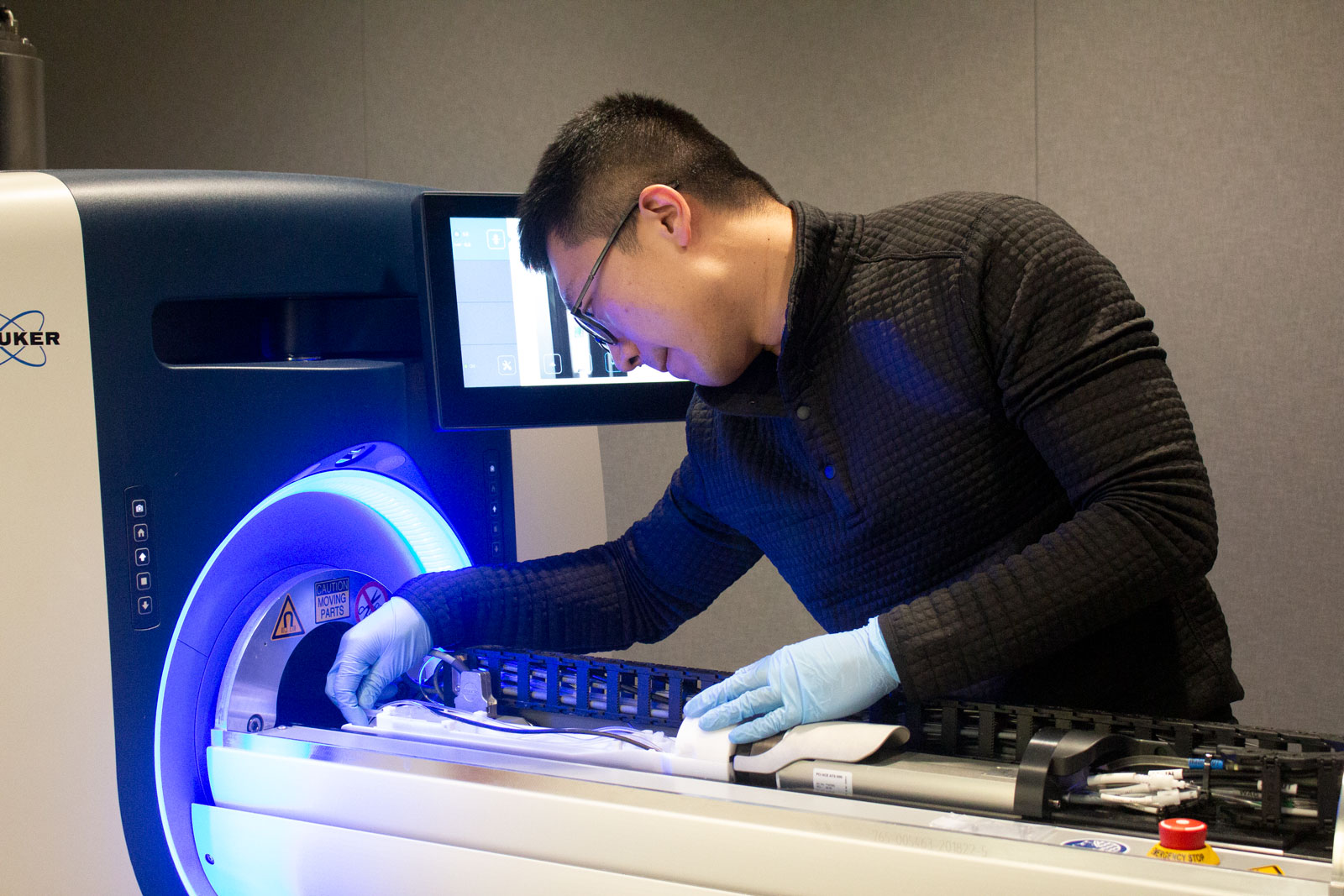Northeastern’s Tao Sun overcomes barriers to brain drug delivery with focused ultrasound

Tao Sun using an MRI machine to visualize the blood-brain barrier opening after application of FUS. Photo: Annetta Stogniew
Tao Sun, Assistant Professor of Bioengineering and member of the Institute of Chemical Imaging of Living Systems at Northeastern University, is penetrating barriers in drug delivery to the brain — one air bubble at a time. He and his team are experimenting with the burgeoning field of focused ultrasound (FUS) and not just for its precise imaging capabilities.
Ultrasound is a medical imaging method that uses high-frequency sound waves to visualize internal bodily processes and is commonly used to generate photos about developing fetuses. But Sun’s lab is investigating its lesser known applications, such as delivering drugs to the brain and improving the body’s immune responses to combat cancer.
“The brain has a whole lot of parts that we don’t understand yet,” says Sun. “We know that FUS can deliver drugs but … we can also bring more important immune cells to the diseased area.”
There are already drugs to treat conditions like Alzheimer’s Disease and glioblastoma: the issue is administering them. Neurologists are thwarted by the physical challenge of the blood-brain barrier, a network of tightly-spaced cells that surround blood vessels in the brain. This cell barrier prevents toxins in the bloodstream from entering the brain — a “kind of natural defense system,” says Sun.
“The problem is, whenever you want to treat the brain, you have no tools to deliver the drug because of this super tight barrier.”
But FUS can get the drug through, with the help of tiny air bubbles injected into the bloodstream. When ultrasound waves are fired at the brain, these microbubbles reflect those waves at a much higher frequency than human tissue. These reverberations cause the bubble to expand and briefly weaken the blood-brain barrier. For the several hours that the barrier is weakened, drugs present in the bloodstream can pass into the brain.
“This is purely non-invasive, or minimally invasive, so you don’t really need your scalpel. You don’t really need a crazy kind of laser…all the other modalities, like magnetic field, electric, or even optical tools don’t necessarily have the same kind of specificity or penetration depth,” says Sun.
Just this year, results from Sun’s experiment about the most effective microbubble shape for drug delivery were published in Proceedings of the National Academy of Sciences (PNAS).
While scientists at Brigham and Women’s Hospital have begun clinical trials of FUS for humans, Sun plans to stick to animal testing for now because his focus is more science-driven than clinical.
One application he tests is the impact of FUS on administration of chemotherapy treatment to the brain. The process starts with implanting a tumor in the brain of a mouse. Once a tumor develops, the team shaves the animal’s head and applies gel to the area to assist the transmission of ultrasound waves. An ultrasound probe is pointed at the shaved area and ultrasound waves are fired while microbubbles are injected into the bloodstream.
In Sun’s experiments, the blood-brain barrier is only opened for one or two minutes. But this is enough time for the chemotherapy drugs to slip into the animal’s brain. When treatment is over, the subject is placed in a miniature MRI machine.
“We can use MRI as a really nice tool to visualize the blood-brain barrier opening, because before opening we cannot see the leakage of the MRI contrast agent,” explains Sun. “Afterwards we can assess the treatment benefits like tumor shrinkage.”
One such experiment from Sun’s lab optimized FUS methods for delivering chemotherapy to mice with Glioblastoma and in doing so improved mice’s survival benefits.
Boosting brain immunity to fight disease — a new frontier for FUS
Along with opening the blood-brain barrier, there’s another promising FUS application. It’s called immunomodulation, the process of changing the body’s immune system using external agents.
According to Sun, Alzheimer’s and brain cancer may induce poor conditions in the immune environment of the brain. Scientists suspect that ultrasound can strengthen the immune system against these diseases by migrating immune cells to the brain.
“We are thinking maybe instead of just changing the transportation of drugs, we can also change the trafficking of the cells at the same time. If we have ultrasound, in addition to delivering more drugs, we can also bring more important immune cells,” Sun says.
He hopes to confirm or deny his theory by measuring the proportion of immune cells in the brain before and after treatment using a colored dye in the brain tissue. If this is successful, FUS will have a monumental impact not just on drug delivery, but in supporting the brain’s immunity.
Sun already has immunomodulation experiments in the works, and has received the Young Investigator Award this year for his leadership in this area of research.
Story from the Science Media Lab.
Last Updated on October 13, 2023
